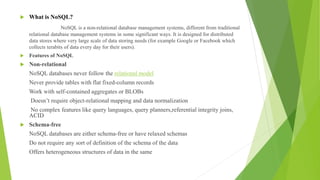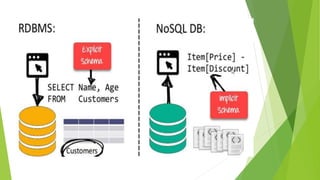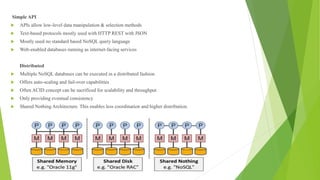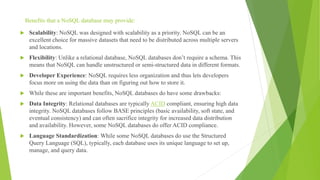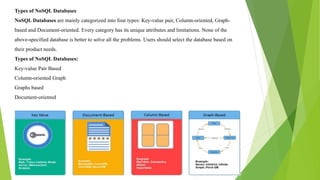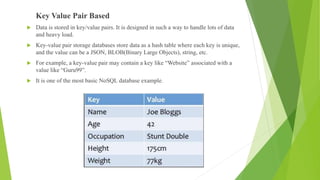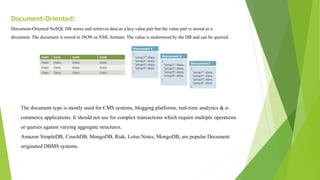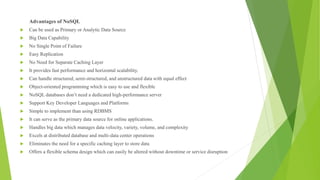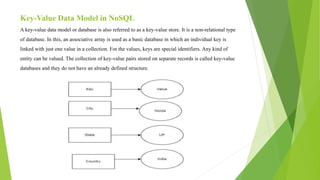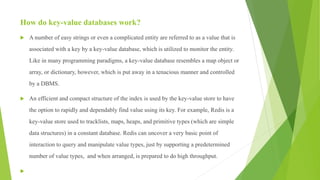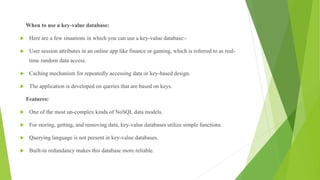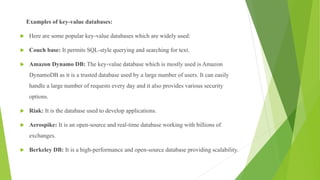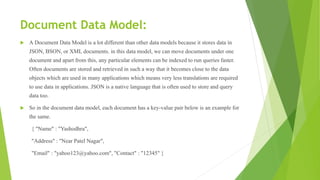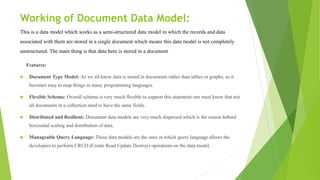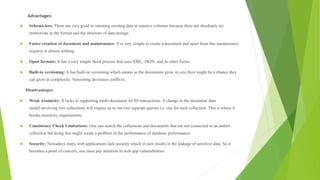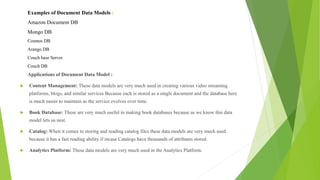unit2-ppt1.pptx
- 1. ’üĄ What is NoSQL? NoSQL is a non-relational database management systems, different from traditional relational database management systems in some significant ways. It is designed for distributed data stores where very large scale of data storing needs (for example Google or Facebook which collects terabits of data every day for their users). ’üĄ Features of NoSQL ’üĄ Non-relational NoSQL databases never follow the relational model Never provide tables with flat fixed-column records Work with self-contained aggregates or BLOBs DoesnŌĆÖt require object-relational mapping and data normalization No complex features like query languages, query planners,referential integrity joins, ACID ’üĄ Schema-free NoSQL databases are either schema-free or have relaxed schemas Do not require any sort of definition of the schema of the data Offers heterogeneous structures of data in the same
- 3. Brief History of NoSQL Databases ’üĄ 1998- Carlo Strozzi use the term NoSQL for his lightweight, open-source relational database ’üĄ 2000- Graph database Neo4j is launched ’üĄ 2004- Google BigTable is launched ’üĄ 2005- CouchDB is launched ’üĄ 2007- The research paper on Amazon Dynamo is released ’üĄ 2008- Facebooks open sources the Cassandra project ’üĄ 2009- The term NoSQL was reintroduced
- 4. Simple API ’üĄ APIs allow low-level data manipulation & selection methods ’üĄ Text-based protocols mostly used with HTTP REST with JSON ’üĄ Mostly used no standard based NoSQL query language ’üĄ Web-enabled databases running as internet-facing services Distributed ’üĄ Multiple NoSQL databases can be executed in a distributed fashion ’üĄ Offers auto-scaling and fail-over capabilities ’üĄ Often ACID concept can be sacrificed for scalability and throughput ’üĄ Only providing eventual consistency ’üĄ Shared Nothing Architecture. This enables less coordination and higher distribution.
- 5. Benefits that a NoSQL database may provide: ’üĄ Scalability: NoSQL was designed with scalability as a priority. NoSQL can be an excellent choice for massive datasets that need to be distributed across multiple servers and locations. ’üĄ Flexibility: Unlike a relational database, NoSQL databases donŌĆÖt require a schema. This means that NoSQL can handle unstructured or semi-structured data in different formats. ’üĄ Developer Experience: NoSQL requires less organization and thus lets developers focus more on using the data than on figuring out how to store it. ’üĄ While these are important benefits, NoSQL databases do have some drawbacks: ’üĄ Data Integrity: Relational databases are typically ACID compliant, ensuring high data integrity. NoSQL databases follow BASE principles (basic availability, soft state, and eventual consistency) and can often sacrifice integrity for increased data distribution and availability. However, some NoSQL databases do offer ACID compliance. ’üĄ Language Standardization: While some NoSQL databases do use the Structured Query Language (SQL), typically, each database uses its unique language to set up, manage, and query data.
- 6. Types of NoSQL Databases NoSQL Databases are mainly categorized into four types: Key-value pair, Column-oriented, Graph- based and Document-oriented. Every category has its unique attributes and limitations. None of the above-specified database is better to solve all the problems. Users should select the database based on their product needs. Types of NoSQL Databases: Key-value Pair Based Column-oriented Graph Graphs based Document-oriented
- 7. Key Value Pair Based ’üĄ Data is stored in key/value pairs. It is designed in such a way to handle lots of data and heavy load. ’üĄ Key-value pair storage databases store data as a hash table where each key is unique, and the value can be a JSON, BLOB(Binary Large Objects), string, etc. ’üĄ For example, a key-value pair may contain a key like ŌĆ£WebsiteŌĆØ associated with a value like ŌĆ£Guru99ŌĆØ. ’üĄ It is one of the most basic NoSQL database example.
- 8. Column-based ’üĄ Column-oriented databases work on columns and are based on BigTable paper by Google. Every column is treated separately. Values of single column databases are stored contiguously. ’üĄ Column-based NoSQL databases are widely used to manage data warehouses, business intelligence, CRM, Library card catalogs, ’üĄ HBase, Cassandra, HBase, Hypertable are NoSQL query examples of column based database.
- 9. Document-Oriented: Document-Oriented NoSQL DB stores and retrieves data as a key value pair but the value part is stored as a document. The document is stored in JSON or XML formats. The value is understood by the DB and can be queried. The document type is mostly used for CMS systems, blogging platforms, real-time analytics & e- commerce applications. It should not use for complex transactions which require multiple operations or queries against varying aggregate structures. Amazon SimpleDB, CouchDB, MongoDB, Riak, Lotus Notes, MongoDB, are popular Document originated DBMS systems.
- 10. Graph-Based A graph type database stores entities as well the relations amongst those entities. The entity is stored as a node with the relationship as edges. An edge gives a relationship between nodes. Every node and edge has a unique identifier. Compared to a relational database where tables are loosely connected, a Graph database is a multi- relational in nature. Traversing relationship is fast as they are already captured into the DB, and there is no need to calculate them. Graph base database mostly used for social networks, logistics, spatial data. Neo4J, Infinite Graph, OrientDB, FlockDB are some popular graph-based databases.
- 11. Advantages of NoSQL ’üĄ Can be used as Primary or Analytic Data Source ’üĄ Big Data Capability ’üĄ No Single Point of Failure ’üĄ Easy Replication ’üĄ No Need for Separate Caching Layer ’üĄ It provides fast performance and horizontal scalability. ’üĄ Can handle structured, semi-structured, and unstructured data with equal effect ’üĄ Object-oriented programming which is easy to use and flexible ’üĄ NoSQL databases donŌĆÖt need a dedicated high-performance server ’üĄ Support Key Developer Languages and Platforms ’üĄ Simple to implement than using RDBMS ’üĄ It can serve as the primary data source for online applications. ’üĄ Handles big data which manages data velocity, variety, volume, and complexity ’üĄ Excels at distributed database and multi-data center operations ’üĄ Eliminates the need for a specific caching layer to store data ’üĄ Offers a flexible schema design which can easily be altered without downtime or service disruption
- 12. Disadvantages of NoSQL ’üĄ No standardization rules ’üĄ Limited query capabilities ’üĄ RDBMS databases and tools are comparatively mature ’üĄ It does not offer any traditional database capabilities, like consistency when multiple transactions are performed simultaneously. ’üĄ When the volume of data increases it is difficult to maintain unique values as keys become difficult ’üĄ DoesnŌĆÖt work as well with relational data ’üĄ The learning curve is stiff for new developers ’üĄ Open source options so not so popular for enterprises.
- 13. Key-Value Data Model in NoSQL A key-value data model or database is also referred to as a key-value store. It is a non-relational type of database. In this, an associative array is used as a basic database in which an individual key is linked with just one value in a collection. For the values, keys are special identifiers. Any kind of entity can be valued. The collection of key-value pairs stored on separate records is called key-value databases and they do not have an already defined structure.
- 14. How do key-value databases work? ’üĄ A number of easy strings or even a complicated entity are referred to as a value that is associated with a key by a key-value database, which is utilized to monitor the entity. Like in many programming paradigms, a key-value database resembles a map object or array, or dictionary, however, which is put away in a tenacious manner and controlled by a DBMS. ’üĄ An efficient and compact structure of the index is used by the key-value store to have the option to rapidly and dependably find value using its key. For example, Redis is a key-value store used to tracklists, maps, heaps, and primitive types (which are simple data structures) in a constant database. Redis can uncover a very basic point of interaction to query and manipulate value types, just by supporting a predetermined number of value types, and when arranged, is prepared to do high throughput. ’üĄ
- 15. When to use a key-value database: ’üĄ Here are a few situations in which you can use a key-value database:- ’üĄ User session attributes in an online app like finance or gaming, which is referred to as real- time random data access. ’üĄ Caching mechanism for repeatedly accessing data or key-based design. ’üĄ The application is developed on queries that are based on keys. Features: ’üĄ One of the most un-complex kinds of NoSQL data models. ’üĄ For storing, getting, and removing data, key-value databases utilize simple functions. ’üĄ Querying language is not present in key-value databases. ’üĄ Built-in redundancy makes this database more reliable.
- 16. Advantages: ’üĄ It is very easy to use. Due to the simplicity of the database, data can accept any kind, or even different kinds when required. ’üĄ Its response time is fast due to its simplicity, given that the remaining environment near it is very much constructed and improved. ’üĄ Key-value store databases are scalable vertically as well as horizontally. ’üĄ Built-in redundancy makes this database more reliable. Disadvantages: ’üĄ As querying language is not present in key-value databases, transportation of queries from one database to a different database cannot be done. ’üĄ The key-value store database is not refined. You cannot query the database without a key.
- 17. Examples of key-value databases: ’üĄ Here are some popular key-value databases which are widely used: ’üĄ Couch base: It permits SQL-style querying and searching for text. ’üĄ Amazon Dynamo DB: The key-value database which is mostly used is Amazon DynamoDB as it is a trusted database used by a large number of users. It can easily handle a large number of requests every day and it also provides various security options. ’üĄ Riak: It is the database used to develop applications. ’üĄ Aerospike: It is an open-source and real-time database working with billions of exchanges. ’üĄ Berkeley DB: It is a high-performance and open-source database providing scalability.
- 18. Document Data Model: ’üĄ A Document Data Model is a lot different than other data models because it stores data in JSON, BSON, or XML documents. in this data model, we can move documents under one document and apart from this, any particular elements can be indexed to run queries faster. Often documents are stored and retrieved in such a way that it becomes close to the data objects which are used in many applications which means very less translations are required to use data in applications. JSON is a native language that is often used to store and query data too. ’üĄ So in the document data model, each document has a key-value pair below is an example for the same. { "Name" : "Yashodhra", "Address" : "Near Patel Nagar", "Email" : "yahoo123@yahoo.com", "Contact" : "12345" }
- 19. Working of Document Data Model: This is a data model which works as a semi-structured data model in which the records and data associated with them are stored in a single document which means this data model is not completely unstructured. The main thing is that data here is stored in a document. Features: ’üĄ Document Type Model: As we all know data is stored in documents rather than tables or graphs, so it becomes easy to map things in many programming languages. ’üĄ Flexible Schema: Overall schema is very much flexible to support this statement one must know that not all documents in a collection need to have the same fields. ’üĄ Distributed and Resilient: Document data models are very much dispersed which is the reason behind horizontal scaling and distribution of data. ’üĄ Manageable Query Language: These data models are the ones in which query language allows the developers to perform CRUD (Create Read Update Destroy) operations on the data model.
- 20. Advantages: ’üĄ Schema-less: These are very good in retaining existing data at massive volumes because there are absolutely no restrictions in the format and the structure of data storage. ’üĄ Faster creation of document and maintenance: It is very simple to create a document and apart from this maintenance requires is almost nothing. ’üĄ Open formats: It has a very simple build process that uses XML, JSON, and its other forms. ’üĄ Built-in versioning: It has built-in versioning which means as the documents grow in size there might be a chance they can grow in complexity. Versioning decreases conflicts. Disadvantages: ’üĄ Weak Atomicity: It lacks in supporting multi-document ACID transactions. A change in the document data model involving two collections will require us to run two separate queries i.e. one for each collection. This is where it breaks atomicity requirements. ’üĄ Consistency Check Limitations: One can search the collections and documents that are not connected to an author collection but doing this might create a problem in the performance of database performance. ’üĄ Security: Nowadays many web applications lack security which in turn results in the leakage of sensitive data. So it becomes a point of concern, one must pay attention to web app vulnerabilities.
- 21. Examples of Document Data Models : Amazon Document DB Mongo DB Cosmos DB Arango DB Couch base Server Couch DB Applications of Document Data Model : ’üĄ Content Management: These data models are very much used in creating various video streaming platforms, blogs, and similar services Because each is stored as a single document and the database here is much easier to maintain as the service evolves over time. ’üĄ Book Database: These are very much useful in making book databases because as we know this data model lets us nest. ’üĄ Catalog: When it comes to storing and reading catalog files these data models are very much used because it has a fast reading ability if incase Catalogs have thousands of attributes stored. ’üĄ Analytics Platform: These data models are very much used in the Analytics Platform.
